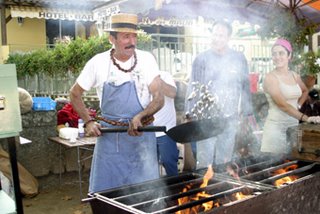Fête de Chataigne - Chestnut Festival
 The sweet chestnut tree is prevalent in the wooded slopes near some of our villages. These trees can live for several centuries and reach 35 metres high . A spiky, prickly husk protects the actual fruit - the chestnut - which is rich in starch and is a highly valued crop.
The sweet chestnut tree is prevalent in the wooded slopes near some of our villages. These trees can live for several centuries and reach 35 metres high . A spiky, prickly husk protects the actual fruit - the chestnut - which is rich in starch and is a highly valued crop.The sweet chestnut tree spreads rapidly in the Var. It thrives on the acid soil of the Massif des Maures , where there are 2500 hectares of chestnut groves spread across the municipalities of Collobrières , La Garde Freinet ,Gonfaron , Les Mayons and Pignans .
Since the beginning of the 20th century , serious diseases led to the disappearance of large areas of chestnut groves , but the introduction of new varieties and the modernisation of production soon replanished the number of chestnut trees in the region.
The sweet chestnut is primarily sold to be eaten whole - usually roasted . It is also made into jam, cream, flour for making cakes or bread and glazed or candied chestnuts - "marrons glacés".
The sweet chestnut is rich in carbohydrates , it is good for blood circulation and is considered as a tonic for the nervous system .
Chestnut Festivals - the "fêtes des chataignes" - are celebrated in villages throughout the region between October 15 and November 15 each year. At these huge street fairs you can learn more about the sweet chestnut than you would think possible - as well as buy steaming paper bags full of freshly roasted chestnuts and other chestnut products. The atmosphere is one of celebration, very lively and typically Provençale. Lots of stall, music, food , coffee and pastis.
The most famous Fêtes de Chataigne" is that of Collobrières , it takes place on the last three weekends of October .
The Confiserie Azurienne on bvd Koenig, Collobrières (9am–noon & 2–6pm) is an efficient and modern manufacturer of all things chestnut: ice cream, jam, nougat, purée and marrons glacés. Next door is the Museum of the Marron Glacé with an exhibition of the production processes of marron glacés (candied chestnuts) over the centuries.
Labels: chataigne, chestnuts, Collobrières


2 Comments:
Love the photo - he is so stereotypically French looking!
We were at a Chestnut festival in France last year - it seemed strange to be eating roasted chestnuts in the warm sunshine; I usually associate them with snowy days here in Boston. Does anybody have any recipes for warm dishes with chestnuts?
Post a Comment
<< Home